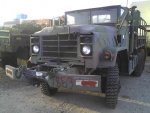71DeuceAK, dunno where ya got the cyanide intel but it is false. The "guilty" parties in the dust / fumes are isocyanates ( think super glue ). This is what makes this coating stick "like glue" and be "tough as nails". Dupont had a similar (chemically) product under the Imron brand. Beautiful finish, hard as granite, deadly if inhaled or absorbed ( usually through the eyes or other mucus memebranes ). The primer was known "affectionately" as YELLOW DEATH. Also potentially deadly via the same routes during abrasion, stripping, or other means of removal.
The GOOD news : if it's in good shape, there isn't a better surface on the planet to paint over. As noted above, clean, no bare metal ( prime with epoxy ), and a little rough ( it's normal state is perfect, or roughen with 320 if shiny ). Once those conditions are met, spray, roll, brush, throw whatever you want on it.






